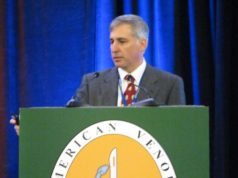
Results of a 12-month study conducted by a group of Commonwealth physicians have demonstrated that endovenous valve formation in the deep venous system is feasible. Presented in the International Session at the annual meeting of the American Venous Forum (VENOUS 2020; 3–6 March, Amelia Island, USA), it was revealed that clinical improvement was sustained to a year in the majority of patients studied.
The problem of chronic venous insufficiency, resulting from superficial reflux, deep vein reflux and venous obstruction, is widespread and connected to significant levels of morbidity, according to investigator Ramon Varcoe (Prince of Wales Private Hospital, Randwick, Australia). He also highlighted that, in the past, therapeutic approaches to deep vein reflux that have involved surgery or implantation have been unable to show durable results or gain widespread adoption.
In this feasibility study, which Varcoe performed alongside colleagues from New Zealand and Canada, the goal was to assess both the safety and effectiveness of endovenous formation, of autogenous deep vein valves, in patients with deep vein reflux. Although this investigation is still ongoing, Varcoe was able to provide results for the first 14 patients treated.
Included in the study were patients with deep vein reflux and symptoms of chronic venous insufficiency (CEAP class C4–C6) who were not responsive to conservative therapies. Once this had been established, these patients were treated with endovenous valve formation (EVF) across five centres in Australia, New Zealand and Canada. In terms of exclusion criteria, patients with outflow obstruction were not a part of this investigation.
Outlining the method, Varcoe explained that retrograde percutaneous access was gained through the common femoral vein, while venography and intravascular ultrasound were employed as means of locating potential treatment sites. Additionally, both intravascular ultrasound and venography were used to assess valve functionality.
Following their procedure, patients received low-molecular-weight heparin injections for seven days, before a six-month period of anticoagulation. The follow-up performed by Varcoe et al included duplex ultrasound, a physical examination and the revised Venous Clinical Severity Score (VCSS).
Out of the 14 patients, four were clinical class C4, four were C5, and six were C6. In terms of the aetiological distribution of this cohort, ten were primary, and four were secondary.
Focusing on the results, Varcoe underlined that one or more monocuspid valves were formed in 93% of these patients (n=13), with one valve formation completed in six patients, two formations in six patients, and three formations in one patient. On the other hand, the anatomy of the one other patient would not accommodate successful valve formation.
Shifting the discussion towards follow-up, which ranged from 30 days to 12 months, the presenter noted that no occlusive deep vein thrombosis was reported during this period. Non-symptomatic mural thrombus was detected in four patients, though this was resolved in all of those affected by 90 days. There were six patients in whom access site adverse events occurred, and one who experienced symptomatic arteriovenous fistula that was resolved with compression.
With regards to patients who were treated successfully with endovenous valve formation, and completed 1 year follow up (n=10), the VCSS score at 210 days and one year improved by a mean average of 5.2 points and 6.3 points, respectively. Varcoe added that 80% (n=8) of patients experienced an improvement of four or more VCSS points at one-year follow-up assessment, with all patients improving by at least three points.
Finally, Varcoe confirmed that reflux time was not shown to correlate with clinical improvement, as well as assuring those in attendance that further study of appropriate haemodynamic metrics is ongoing. Although further research into endovenous valve formation is required following this feasibility study, with more results to come, he concluded that the treatment has been demonstrated as feasible.












